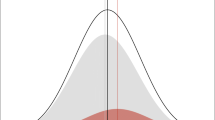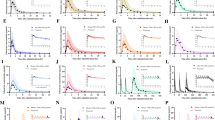Abstract
Objectives
The aims of this study were to characterize the population frequency of PEPT2 (SLC15A2) polymorphic variants in three Asian ethnic populations, namely Chinese, Malay and Asian Indian, and to investigate the associations of ethnicity (Chinese vs. Asian Indian), PEPT2 haplotype and cephalexin pharmacokinetics in healthy Asian subjects.
Methods
PEPT2 polymorphisms were screened from a cohort of 96 Chinese, 96 Malay and 96 Asian Indian subjects. Cephalexin (1000 mg, orally) pharmacokinetics was characterized in an additional 15 Chinese and 15 Asian Indian healthy subjects. These 30 subjects were subsequently genotyped for their PEPT2 polymorphisms.
Results
In total, ten common single nucleotide polymorphisms (SNPs) were detected in the three populations, forming two PEPT2 haplotypes. There were significant ethnic differences in PEPT2 haplotype distribution: the frequencies of the *1 and *2 alleles were 0.307 and 0.693 in the Chinese population, 0.495 and 0.505 in the Malay population and 0.729 and 0.271 in Asian Indian population, respectively. The C max of cephalexin was significantly lower in the Chinese (29.80 ± 4.09 μg ml−1) population than in the Asian Indian one (33.29 ± 4.97 μg ml−1; P = 0.045). This difference could be explained by the higher average body weight of the Chinese population. There was no other significant difference in cephalexin pharmacokinetics between either ethnic or PEPT2 genotype groups.
Conclusion
PEPT2 polymorphism distributions differ significantly between Chinese, Malay and Asian Indian populations. However, cephalexin pharmacokinetics is not meaningfully different between Chinese and Asian Indians. The association between the PEPT2 haplotype and cephalexin pharmacokinetics could not be confirmed, and future studies under better controlled conditions are needed.
Similar content being viewed by others
References
Takahashi K, Nakamura N, Terada T, Okano T, Futami T, Saito H, Inui KI (1998) Interaction of beta-lactam antibiotics with H+ /peptide cotransporters in rat renal brush-border membranes. J Pharmacol Exp Ther 286(2):1037–1042
Smith DE, Pavlova A, Berger UV, Hediger MA, Yang T, Huang YG, Schnermann JB (1998) Tubular localization and tissue distribution of peptide transporters in rat kidney. Pharm Res 15(8):1244–1249
Shen H, Smith DE, Yang T, Huang YG, Schnermann JB, Brosius FC (1999) Localization of PEPT1 and PEPT2 proton-coupled oligopeptide transporter mRNA and protein in rat kidney. Am J Physiol 276(5 Pt 2):F658–665
Ganapathy ME, Huang W, Wang H, Ganapathy V, Leibach FH (1998) Valacyclovir: a substrate for the intestinal and renal peptide transporters PEPT1 and PEPT2. Biochem Biophys Res Commun 246(2):470–475
Pinsonneault J, Nielsen CU, Sadée W (2004) Genetic variants of the human H+/dipeptide transporter PEPT2: analysis of haplotype functions. J Pharmacol Exp Ther 311(3):1088–1096
Bahadduri PM, D’Souza VM, Pinsonneault JK, Sadée W, Bao S, Knoell DL, Swaan PW (2005) Functional characterization of the peptide transporter PEPT2 in primary cultures of human upper airway epithelium. Am J Respir Cell Mol Biol 32(4):319–325
Maïza A, Daley-Yates PT (1993) Variability in the renal clearance of cephalexin in experimental renal failure. J Pharmacokinet Biopharm 21(1):19–30
Gustaferro CA, Steckelberg JM (1991) Cephalosporin antimicrobial agents and related compounds. Mayo Clin Proc 66(10):1064–73
Terada T, Saito H, Mukai M, Inui K (1997) Recognition of beta-lactam antibiotics by rat peptide transporters, PEPT1 and PEPT2, in LLC-PK1 cells. Am J Physiol 273(5 Pt 2):F706–711
Granero L, Gimeno MJ, Torres-Molina F, Chesa-Jiménez J, Peris JE (1994) Studies on the renal excretion mechanisms of cefadroxil. Drug Metab Dispos 22(3):447–450
Padoin C, Tod M, Perret G, Petitjean O (1998) Analysis of the pharmacokinetic interaction between cephalexin and quinapril by a nonlinear mixed-effect model. Antimicrob Agents Chemother 42(6):1463–1469
Luckner P, Brandsch M (2005) Interaction of 31 beta-lactam antibiotics with the H+/peptide symporter PEPT2: analysis of affinity constants and comparison with PEPT1. Eur J Pharm Biopharm 59(1):17–24
Hori R, Okumura K, Kamiya A, Nihira H, Nakano H (1983) Ampicillin and cephalexin in renal insufficiency. Clin Pharmacol Ther 34(6):792–798
Kamiya A, Okumura K, Hori R (1983) Quantitative investigation on renal handling of drugs in rabbits, dogs, and humans. J Pharm Sci 72(4):440–443
Yin OQ, Tomlinson B, Chow MS (2006) Variability in renal clearance of substrates for renal transporters in Chinese subjects. J Clin Pharmacol 46(2):157–163
Pelloquin F, Lamelin JP, Lenoir GM (1986) Human B lymphocytes immortalization by Epstein-Barr virus in the presence of cyclosporin A. In Vitro Cell Dev Biol 22(12):689–694
Ying GW, Lee CG, Lee EJ (2004) A naturally occurring -263G/C variant of the human AA-NAT gene and overnight melatonin production. Mol Genet Metab 81(1):65–69
Kovach PM, Lantz RJ, Brier G (1991) High-performance liquid chromatographic determination of loracarbef, a potential metabolite, cefaclor and cephalexin in human plasma, serum and urine. J Chromatogr 567(1):129–139
Barbhaiya RH (1996) A pharmacokinetic comparison of cefadroxil and cephalexin after administration of 250, 500 and 1000 mg solution doses. Biopharm Drug Dispos 17(4):319–330
Brogard JM, Pinget M, Dorner M, Lavillaureix J (1975) Determination of cefalexin pharmacokinetics and dosage adjustments in relation to renal function. J Clin Pharmacol 15(10):666–673
Actor P, Pitkin DH, Lucyszyn G, Weisbach JA, Bran JL (1976) Cefatrizine (SK&F 60771), a new oral cephalosporin: serum levels and urinary recovery in humans after oral or intramuscular administration–comparative study with cephalexin and cefazolin. Antimicrob Agents Chemother 9(5):800–803
Pfeffer M, Jackson A, Ximenes J, de Menezes JP (1977) Comparative human oral clinical pharmacology of cefadroxil, cephalexin, and cephradine. Antimicrob Agents Chemother 11(2):331–338
Korzeniowski OM, Scheld WM, Sande MA (1977) Comparative pharmacology of cefaclor and cephalexin. Antimicrob Agents Chemother 12(2):157–162
Hartstein AI, Patrick KE, Jones SR, Miller MJ, Bryant RE (1977) Comparison of pharmacological and antimicrobial properties of cefadroxil and cephalexin. Antimicrob Agents Chemother 12(1):93–97
Spyker DA, Thomas BL, Sande MA, Bolton WK (1978) Pharmacokinetics of cefaclor and cephalexin: dosage nomograms for impaired renal function. Antimicrob Agents Chemother 14(2):172–177
Lode H, Stahlmann R, Koeppe P (1979) Comparative pharmacokinetics of cephalexin, cefaclor, cefadroxil, and CGP 9000. Antimicrob Agents Chemother 16(1):1–6
Lecaillon JB, Hirtz JL, Schoeller JP, Humbert G, Vischer W (1980) Pharmacokinetic comparison of cefroxadin (CGP 9000) and cephalexin by simultaneous administration to humans. Antimicrob Agents Chemother 18(5):656–660
Griffith RS, Black HR (1970) Cephalexin. Med Clin North Am 54(5):1229–1244
Herrera-Ruiz D, Knipp GT (2003) Current perspectives on established and putative mammalian oligopeptide transporters. J Pharm Sci 92(4):691–714
Rubio-Aliaga I, Daniel H (2002) Mammalian peptide transporters as targets for drug delivery. Trends Pharmacol Sci 23(9):434–440
Dresser MJ, Leabman MK, Giacomini KM (2001) Transporters involved in the elimination of drugs in the kidney: organic anion transporters and organic cation transporters. J Pharm Sci 90(4):397–421
Acknowledgements
This work was supported by a grant from the National Medical Research Council, Singapore. (NMRC /1014/2005)
Author information
Authors and Affiliations
Corresponding author
Rights and permissions
About this article
Cite this article
Liu, R., Tang, A.M.Y., Tan, Y.L. et al. Interethnic differences of PEPT2 (SLC15A2) polymorphism distribution and associations with cephalexin pharmacokinetics in healthy Asian subjects. Eur J Clin Pharmacol 65, 65–70 (2009). https://doi.org/10.1007/s00228-008-0488-4
Received:
Accepted:
Published:
Issue Date:
DOI: https://doi.org/10.1007/s00228-008-0488-4




